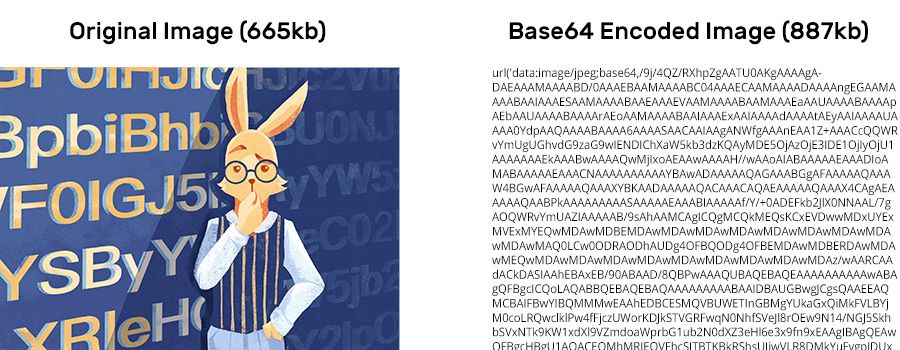Unfortunately, even today, some optimization plugins and blogs suggest "optimizing" your images by encoding them to Base64 and including them directly into your HTML.
In this post, I want to address why, in this day and age, this is almost always a very bad idea. It is a practice that has been carried over from years ago. Back then, web browsers had strict limits on the number of concurrent connections they could send to a server. This meant that an image-heavy website had to queue requests, with each one waiting for the previous to finish. Base64 offered a workaround by using an already open HTTP connection to deliver images embedded directly in the HTML or CSS. This effectively removed the need for an extra roundtrip the browser would otherwise require for each image file.
With the introduction of multiplexing that arrived with HTTP/2, web browsers have become highly efficient in delivering hundreds of files through a single connection. This solves problems that Base64 was intended to address. In fact, Base64 now does more harm than good.
To get to the answer why, we first need to establish what Base64 actually is. To put it simply, Base64 is an encoding scheme used to represent binary data in a text format. This is useful when the storage or delivery medium does not support binary data, such as when embedding an image into a database, CSS file, or HTML. It’s important not to confuse compression with encoding. While compression actually compresses data, encoding simply defines a way how data is encoded, which brings us to the first issue.
Download size increase
Although Base64 is a relatively efficient way to encode binary data, it will, on average, still increase the file size by more than 25%. This not only increases your bandwidth bill, but also increases the download time.

CPU overhead
When delivering images in Base64, the browser first needs to decode the Base64-encoded strings and then decode the images as well, which introduces an extra layer of unnecessary work. Base64 is very efficient, but when you count in the GZip or Brotli processing time that happens on the server to compress the response, the milliseconds can quickly start adding up.
Caching issues
The third issue is perhaps the biggest performance killer, but not necessarily the most obvious at first glance. When a user accesses your website, the browser will automatically cache the images locally and then load them directly from your disk when visiting the same page again. Due to how Base64 works, the browser is unable to store the images locally, so it will always need to fetch them from your server or CDN, which creates extra load on your server and increases your bandwidth bill.
Another issue here is that if your images are embedded in your HTML code, content delivery networks such as BunnyCDN can't cache the files, and they will always be returned from your origin server, which might be thousands of kilometers away.
SEO and user experience
The issues are actually not only limited to performance. By using Base64-encoded images on your website, you might also be hurting both your SEO and user experience as well.
The reason for this is that sharing Base64 images is much harder since they are not actually accessible via a public URL. This means that web crawlers and your users are unable to get links pointing back to your website, which makes sharing content much harder and can potentially hurt your "page rank" as well.
When should you actually use Base64?
Base64 has a lot of uses in technology, but unless you have a very good reason, you should try to avoid using it as part of your HTML or CSS files. There are some edge cases where Base64 might actually be useful.
One such example would be very small images, where the Base64 string is actually smaller than the length of an URL string plus the HTTP request overhead when linking to an image file. Take, for example, a 1x1 pixel transparent PNG. Despite the original image being only 68 bytes in size, factoring in the HTTP headers, it still ends up being bigger than the Base64-encoded string:
Empty transparent pixel:
iVBORw0KGgoAAAANSUhEUgAAAAEAAAABCAQAAAC1HAwCAAAAC0lEQVR42mNkYAAAAAYAAjCB0C8AAAAASUVORK5CYII=If you ever run into a blog that suggests using Base64 to improve performance, make sure to take it with a grain of salt and carefully evaluate whether there are any real benefits that apply to your own use case.


